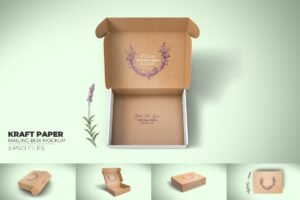I. Introduction
Kraft paper box packaging has emerged as a popular and significant choice.This article aims to explore every aspect of Kraft paper box packaging, from its characteristics and types to its manufacturing process, advantages, applications, trends, and challenges.
II. Characteristics of Kraft Paper Boxes
A. Durability and strength
Kraft paper boxes are renowned for their remarkable durability and strength. The paper itself is thick and sturdy, capable of withstanding the rigors of handling, storage, and transportation. This makes them suitable for a wide range of products, from delicate items to heavy-duty goods.
B. Recyclability and eco-friendliness
One of the key attractions of Kraft paper boxes is their recyclability. They are made from natural fibers, which can be easily recycled and reused, reducing the environmental impact. In an era where sustainability is of paramount importance, this eco-friendly characteristic makes Kraft paper boxes a preferred choice for many businesses and consumers.
C. Versatility in shapes and sizes
Kraft paper boxes come in an array of shapes and sizes, offering flexibility in packaging various products. They can be customized to fit the exact dimensions and requirements of the items being packaged, ensuring a snug and secure fit.
III. Types of Kraft Paper Boxes
A. Regular Kraft Paper Boxes
Regular Kraft paper boxes are the standard options available in the market. They are commonly used for packaging general merchandise, such as books, stationery, and small household items. These boxes are typically mass-produced and come in standard sizes.
B. Customized Kraft Paper Boxes
To meet the specific needs of businesses and brands, customized Kraft paper boxes are becoming increasingly popular. These boxes can be designed with unique shapes, colors, printing, and finishes to create a distinct brand identity. Customization allows for enhanced product presentation and marketing opportunities.

IV. Manufacturing Process of Kraft Paper Boxes
A. Material selection
The choice of Kraft paper is crucial in the manufacturing process. Different grades and qualities of Kraft paper are available, depending on the intended use and requirements. The paper is selected based on factors such as strength, thickness, and printability.
B. Printing and finishing techniques
Once the paper is selected, printing and finishing techniques are employed to add branding elements, designs, and information to the boxes. Various printing methods, including flexography and digital printing, can be used to achieve high-quality and visually appealing results. Finishing options like laminating, varnishing, and embossing can enhance the appearance and durability of the boxes.
V. Advantages of Kraft Paper Box Packaging
A. Cost-effectiveness
Kraft paper is relatively inexpensive compared to other packaging materials, making Kraft paper box packaging a cost-effective option. Additionally, its durability and recyclability contribute to long-term savings.
B. Good protection for contents
The strength and sturdiness of Kraft paper boxes provide excellent protection to the packaged goods. They can safeguard items from damage during handling, shipping, and storage.
C. Branding and marketing opportunities
The customizable nature of Kraft paper boxes allows for creative branding and marketing. Logos, colors, and messaging can be prominently displayed on the boxes, increasing brand visibility and creating a lasting impression on consumers.
VI. Applications of Kraft Paper Boxes
A. In the food industry
Kraft paper boxes are widely used in the food industry for packaging items such as bakery products, snacks, and dry foods. Their natural and eco-friendly characteristics are appealing to consumers who are increasingly conscious of the environment and food safety.
B. In the retail sector
Retailers utilize Kraft paper boxes for packaging various products, including clothing, cosmetics, and small electronics. The boxes can be designed to be visually appealing and enhance the shopping experience.
C. For industrial products
In the industrial sector, Kraft paper boxes are used to package components, spare parts, and other industrial goods. Their durability and strength make them suitable for protecting these items during transportation.
VII. Trends in Kraft Paper Box Packaging
A. Sustainable and minimalist designs
As consumers demand more sustainable packaging options, Kraft paper box packaging is evolving to incorporate minimalist designs that use less material while still maintaining functionality. Eco-friendly inks and finishes are also being utilized to further reduce the environmental impact.
B. Smart packaging integration
The integration of smart technologies into Kraft paper boxes is an emerging trend. This may include features such as QR codes for traceability, RFID tags for inventory management, or sensors for monitoring the condition of the packaged goods.
VIII. Challenges and Considerations
A. Moisture resistance issues
Kraft paper is not highly resistant to moisture, which can be a challenge in some applications. Special coatings or treatments may be required to enhance moisture resistance, especially for products that are prone to moisture damage.
B. Competition from other packaging materials
The packaging industry is highly competitive, and Kraft paper boxes face competition from other materials such as plastic, cardboard, and metal. To remain competitive, manufacturers need to continuously innovate and improve the quality and performance of Kraft paper boxes.
IX. Conclusion
In conclusion, Kraft paper box packaging offers a wide range of benefits and applications. Its durability, recyclability, and cost-effectiveness make it a popular choice in various industries. The ability to customize the boxes for branding and marketing purposes further enhances its value. However, it also faces challenges such as moisture resistance and competition from other materials. By staying abreast of the latest trends and addressing these challenges, the future of Kraft paper box packaging looks promising. As consumers and businesses continue to prioritize sustainability and functionality, Kraft paper boxes are likely to play an even more significant role in the packaging landscape.






